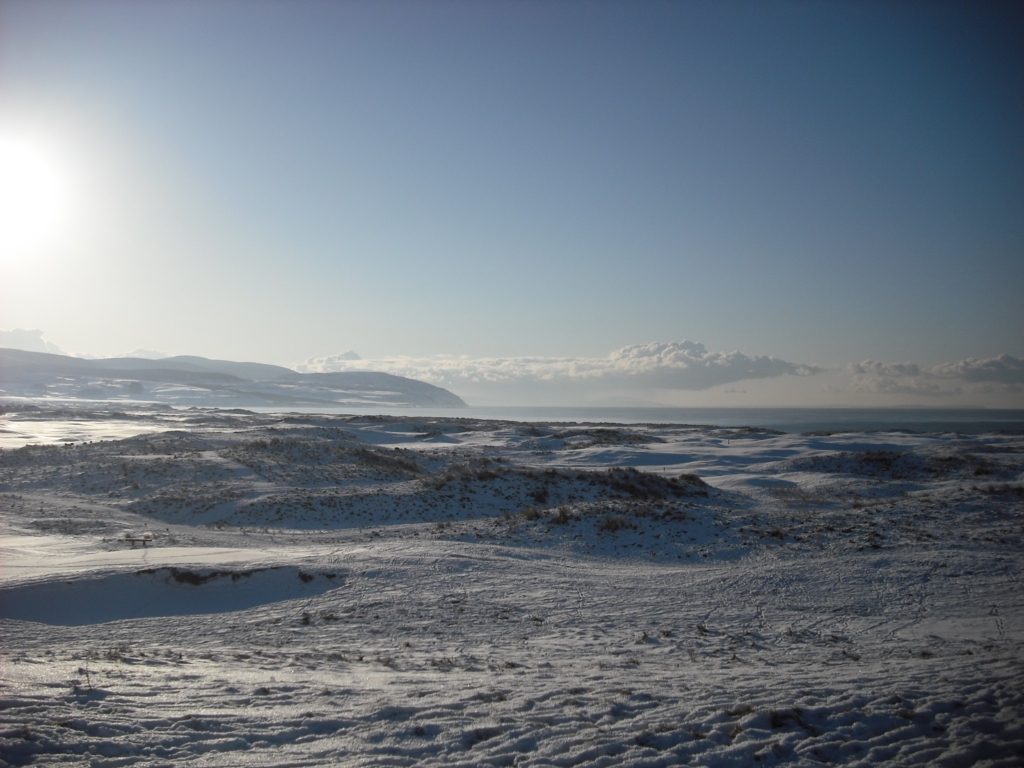
This is not my sign, I borrowed it from a search engine. If you want to know whether or not Machrihanish Dunes is open, you have to venture inside and ask Lorna or Peter!
It seems like one of nature’s sick winter jokes that frost closures coincide with calm, sunny days. Of course, this causes frustration amongst golfers who may have been starved of decent playing weather for weeks. This frustration is only exacerbated by the lack of information emanating from greenkeepers who obviously know why they are shutting the course, but may find it hard to put that information into words that his or her members can easily understand. Even I (the undisputed king of long-winded explanations!) am guilty of this. Machrihanish Dunes was on the verge of being closed last Sunday morning (December 10th) but remained just acceptable for play – information I was delighted to convey to three members whom I consider to be good friends. Speaking with them before they teed off, I quickly realised that despite having been immersed in the game of golf for a long time, they really didn’t completely understand why we feel the need to close the course during periods of frost. It is to their great credit that they cheerily accept and trust my decisions despite not having this information. It is to my detriment that I have not repaid this favour by telling them all they need to know!
How Many Types of Frost Are There?
Types of frost? What am I talking about? It might surprise you to discover that there are two types of frost that could potentially cause course closures, and knowing the difference between the various conditions that cause these potentially damaging scenarios will give you a better understanding of why our closure strategy might at first appear to be a bit random. Surprisingly, it is not all about low temperatures.
TYPE 1: Hard Ground Frost
- Scenario 1) Imagine it is -8C, and it has been for several days. The frost will be in the ground by at least a few inches, and the surface is rock solid. You’d think the course would be closed, wouldn’t you? Not necessarily! As long as the leaves of the grass plants are not themselves frozen with white frost (we’ll get to that later) and remain soft so that they are compliant when you brush them with your hand (and therefore your feet) then there is no reason why the plant should be negatively impacted by walking on it. Because the greens at Machrihanish Dunes have only limited levels of play (for that, read “surface wear”) to deal with during the winter months and because it is relatively warm in Kintyre and we do not expect to suffer from frozen ground for extended periods of time, it is safe to assume that if the ground is already frozen solid and no imminent thaw is expected, then I will happily let you out to play. The only thing that could negatively impact this decision might arise from specific frozen areas on the golf course that we consider to be a health and safety hazard. But closing the course following such a risk assessment is a different issue altogether that I am not going to get into here.
- Scenario 2) Imagine it has been -8C for several days, but you have woken up this morning and it is 5C and there is a big thaw on. You’ve been playing all week and now it is warmer, so obviously the course will be open, won’t it? Not necessarily! This is a very dangerous time for turf, as the upper portion of the plant’s roots are now free to move around in unfrozen soil while the lower section is still trapped in frozen ground. Couple this with the effect that frost has on soil when water freezes and expands, loosening and raising the profile and providing space for roots to move around in such an effective way that we greenkeepers only wish we had a mechanical aeration machine that would work as well, and you have a recipe for severe damage. Imagine you are play-fighting with a pet cat and you grab it by the back leg as it tries to run away while it twists its body at the same time, as they do. There is the potential there for the poor cat to suffer a broken leg. If you think, then, how much more delicate a long grass root is than a cat’s leg—well, you get the idea. Although it may seem nonsensical at first that a course could be open for play when it is -8C but closed the next day when it is 5C, when you consider the effects of that analogy, the potential for catastrophic root damage suddenly seems obvious.
TYPE 2: White Surface Frost
We all know that dew can form when a relatively warm day is followed by a cold, still night, and that when these conditions occur in winter, temperatures are likely to dip to freezing point just before the sun comes up in the morning (invariably the coldest time of night). If this happens, the dew can instantly freeze onto the surface of the grass. Obviously, if the dew has not been taken up by the grass leaf then it must already contain enough moisture internally to allow it to function. If all this water on both the inside and outside of the leaf suddenly freezes and expands, the leaf becomes very vulnerable. We have all seen those superhero films where the villain is frozen with liquid nitrogen and is then smashed into a million pieces with Thor’s hammer or some similar weapon—well, this is exactly what happens to the grass leaf if you or I were to stand on it when it is suddenly frozen in this way. It snaps, and the portion that snaps off dies. A grass leaf that may have been 10mm long is now 3mm long, and if you read last month’s blog, you will know what effect that would have on the plant’s photosynthetic ability at a time when it needs to store all the light energy it can possibly grab. If more than a few people were to walk on a green affected by white frost on even a few days over the course of a winter, the health of that green could be severely impacted.
So, if you turn up to play golf and the greens are white with frost, will the course be closed? The frustrating answer to that is “probably”, but now, more than any other time is when you need to trust our professional judgment, as there will be a precise point when the rising sun brings just enough heat to turn the white frost back into dew or at the very least, slush. At this point, the danger has passed, the functions of the grass leaf return to normal, and we will happily wave you off to go and play golf in the sunshine.
We can determine whether a green affected by white frost is playable by using our experience and such scientific methods as standing on the edge of the green and listening for the tell-tale crunch (closed!), or by rubbing our hand over the surface and visually observing whether the leaves are frozen solid (closed!), or whether things are actually slushier than we initially thought (open!). At first sight last Sunday, we might have expected the course to be temporarily closed as the greens looked white from a distance, but with temperatures at Machrihanish Dunes only dipping to -0.5C, the dew never quite froze solid enough to necessitate this and the three wise men were free to bound their way down the 1st fairway at 8 AM. In an area such as Kintyre where winter temperatures on clear, still mornings regularly bounce around the 0C mark, we quite often find ourselves running around in the minutes before sunrise trying to make informed decisions on whether or not the course is fit for play.

Summary
There are so many things for a greenkeeper to consider when putting together a frost strategy. The topography of every site is different and temperature fluctuations over even a small geographical area can result in a course being considered fit for play while the one next door is justifiably kept closed. I hope that this light-hearted description gives you a better understanding of the scientific reasons why we sometimes feel the need to prohibit you from playing on the course in weather that is invariably perfect for golf, but I’m afraid that the intricacies of the subject mean that sometimes you will just have to trust us! Just be safe in the knowledge, though, that I would never, ever keep the course closed for one minute if I felt that it was free from frost and fit for play. I hate the course being closed just as much as you do–it makes me feel like I have failed!

